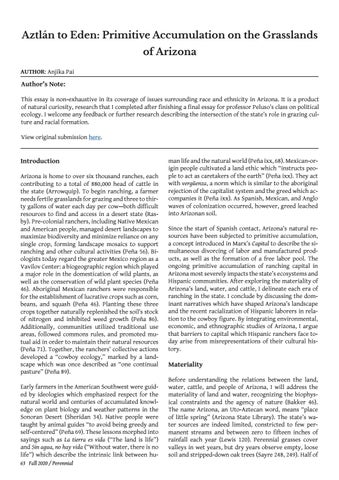Aztlán to Eden: Primitive Accumulation on the Grasslands of Arizona AUTHOR: Anjika Pai
Author’s Note: This essay is non-exhaustive in its coverage of issues surrounding race and ethnicity in Arizona. It is a product of natural curiosity, research that I completed after finishing a final essay for professor Peluso’s class on political ecology. I welcome any feedback or further research describing the intersection of the state’s role in grazing culture and racial formation. View original submission here.
Introduction Arizona is home to over six thousand ranches, each contributing to a total of 880,000 head of cattle in the state (Arrowquip). To begin ranching, a farmer needs fertile grasslands for grazing and three to thirty gallons of water each day per cow—both difficult resources to find and access in a desert state (Rasby). Pre-colonial ranchers, including Native Mexican and American people, managed desert landscapes to maximize biodiversity and minimize reliance on any single crop, forming landscape mosaics to support ranching and other cultural activities (Peña 56). Biologists today regard the greater Mexico region as a Vavilov Center: a biogeographic region which played a major role in the domestication of wild plants, as well as the conservation of wild plant species (Peña 46). Aboriginal Mexican ranchers were responsible for the establishment of lucrative crops such as corn, beans, and squash (Peña 46). Planting these three crops together naturally replenished the soil’s stock of nitrogen and inhibited weed growth (Peña 86). Additionally, communities utilized traditional use areas, followed commons rules, and promoted mutual aid in order to maintain their natural resources (Peña 71). Together, the ranchers’ collective actions developed a “cowboy ecology,” marked by a landscape which was once described as “one continual pasture” (Peña 89). Early farmers in the American Southwest were guided by ideologies which emphasized respect for the natural world and centuries of accumulated knowledge on plant biology and weather patterns in the Sonoran Desert (Sheridan 34). Native people were taught by animal guides “to avoid being greedy and self-centered” (Peña 69). These lessons morphed into sayings such as La tierra es vida (“The land is life”) and Sin agua, no hay vida (“Without water, there is no life”) which describe the intrinsic link between hu63 Fall 2020 / Perennial
man life and the natural world (Peña ixx, 68). Mexican-origin people cultivated a land ethic which “instructs people to act as caretakers of the earth” (Peña ixx). They act with vergüenza, a norm which is similar to the aboriginal rejection of the capitalist system and the greed which accompanies it (Peña ixx). As Spanish, Mexican, and Anglo waves of colonization occurred, however, greed leached into Arizonan soil. Since the start of Spanish contact, Arizona’s natural resources have been subjected to primitive accumulation, a concept introduced in Marx’s Capital to describe the simultaneous divorcing of labor and manufactured products, as well as the formation of a free labor pool. The ongoing primitive accumulation of ranching capital in Arizona most severely impacts the state’s ecosystems and Hispanic communities. After exploring the materiality of Arizona’s land, water, and cattle, I delineate each era of ranching in the state. I conclude by discussing the dominant narratives which have shaped Arizona’s landscape and the recent racialization of Hispanic laborers in relation to the cowboy figure. By integrating environmental, economic, and ethnographic studies of Arizona, I argue that barriers to capital which Hispanic ranchers face today arise from misrepresentations of their cultural history.
Materiality Before understanding the relations between the land, water, cattle, and people of Arizona, I will address the materiality of land and water, recognizing the biophysical constraints and the agency of nature (Bakker 46). The name Arizona, an Uto-Aztecan word, means “place of little spring” (Arizona State Library). The state’s water sources are indeed limited, constricted to few permanent streams and between zero to fifteen inches of rainfall each year (Lewis 120). Perennial grasses cover valleys in wet years, but dry years observe empty, loose soil and stripped-down oak trees (Sayre 248, 249). Half of
